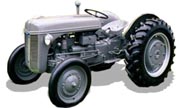Learning2Tractor
Member
I read you don't plough with any tractor under 40hp. At least maybe not on a new unworked field. Don't know if that's right, but it is what I have been reading on more than one site.
If you don't have a front loader or a lawn cutting pull behind implement, what do you use them for? For example, I found a good price on a Kubota B6000e. It is only the tractor. I can only cut the grass with it?
Are all the old tractors over 40hp?
Edit:. I read the Kubota was 10.5 hp. My jd L110 is 17.5, but no pto. I don't know what I'd do with the Kubota.
If you don't have a front loader or a lawn cutting pull behind implement, what do you use them for? For example, I found a good price on a Kubota B6000e. It is only the tractor. I can only cut the grass with it?
Are all the old tractors over 40hp?
Edit:. I read the Kubota was 10.5 hp. My jd L110 is 17.5, but no pto. I don't know what I'd do with the Kubota.
Last edited:
